Critical Criminology: Postmodernism, Emotion, and Crime Links
VerifiedAdded on 2022/12/29
|6
|1324
|71
Essay
AI Summary
This essay delves into critical criminology, examining the enduring influence of New Right Criminology, the postmodern perspective on language's role in shaping thought, and the crucial link between emotions and criminal behavior. The essay critically discusses the New Right's impact on contemporary criminal justice policies, highlighting its focus on individual responsibility and cost-benefit analysis in crime. It further explores how postmodern criminologists view language as a structure that influences thought processes within the criminal context, emphasizing its role in communication and the development of hierarchical perspectives. The essay also investigates the relationship between emotions and crime, arguing that the absence or mismanagement of emotions can contribute to criminal behavior. It references studies that highlight the importance of emotional regulation in controlling impulses and preventing crime. The analysis includes references to various criminological theories and research, providing a comprehensive overview of the subject matter.
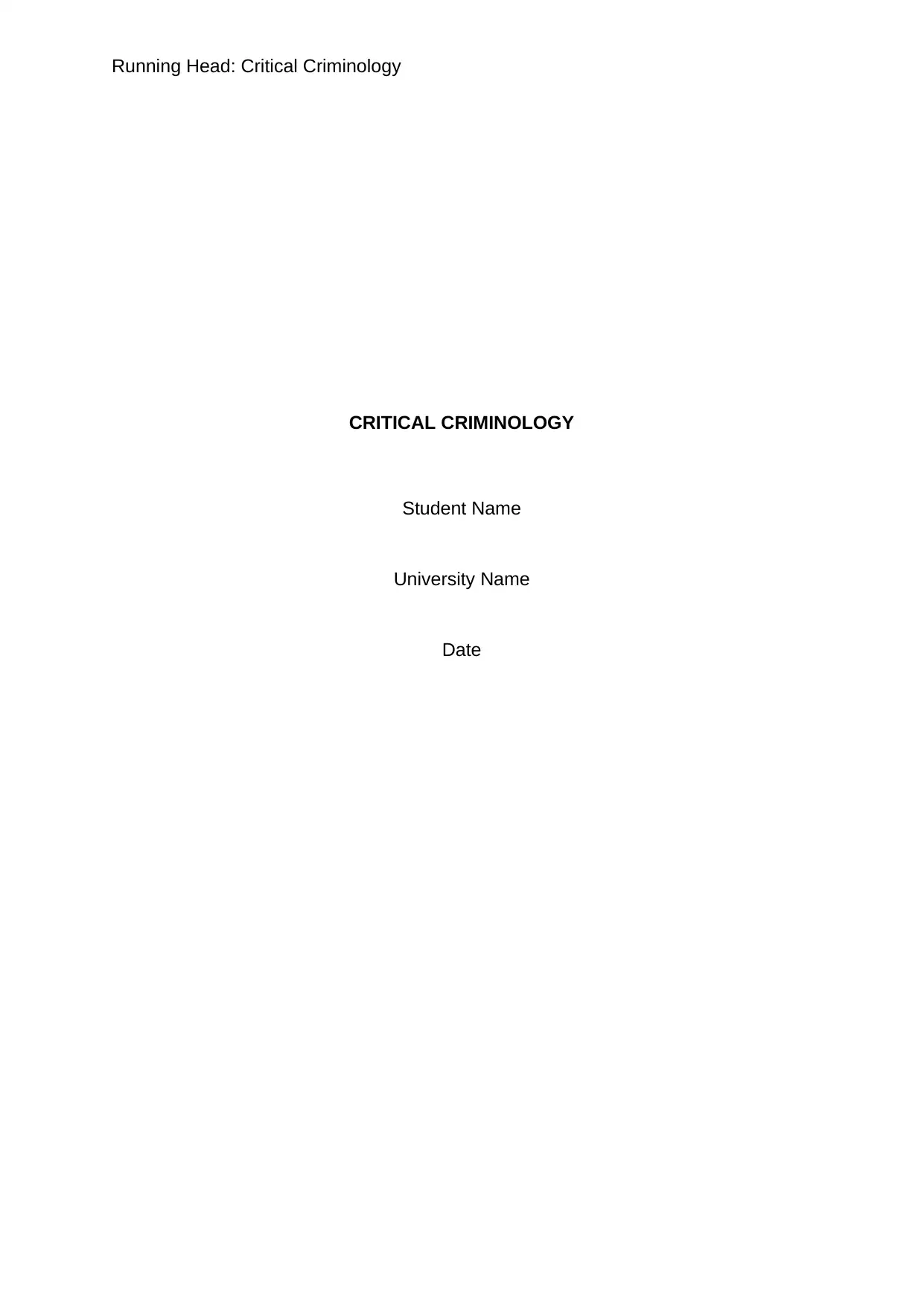
Running Head: Critical Criminology
CRITICAL CRIMINOLOGY
Student Name
University Name
Date
CRITICAL CRIMINOLOGY
Student Name
University Name
Date
Paraphrase This Document
Need a fresh take? Get an instant paraphrase of this document with our AI Paraphraser
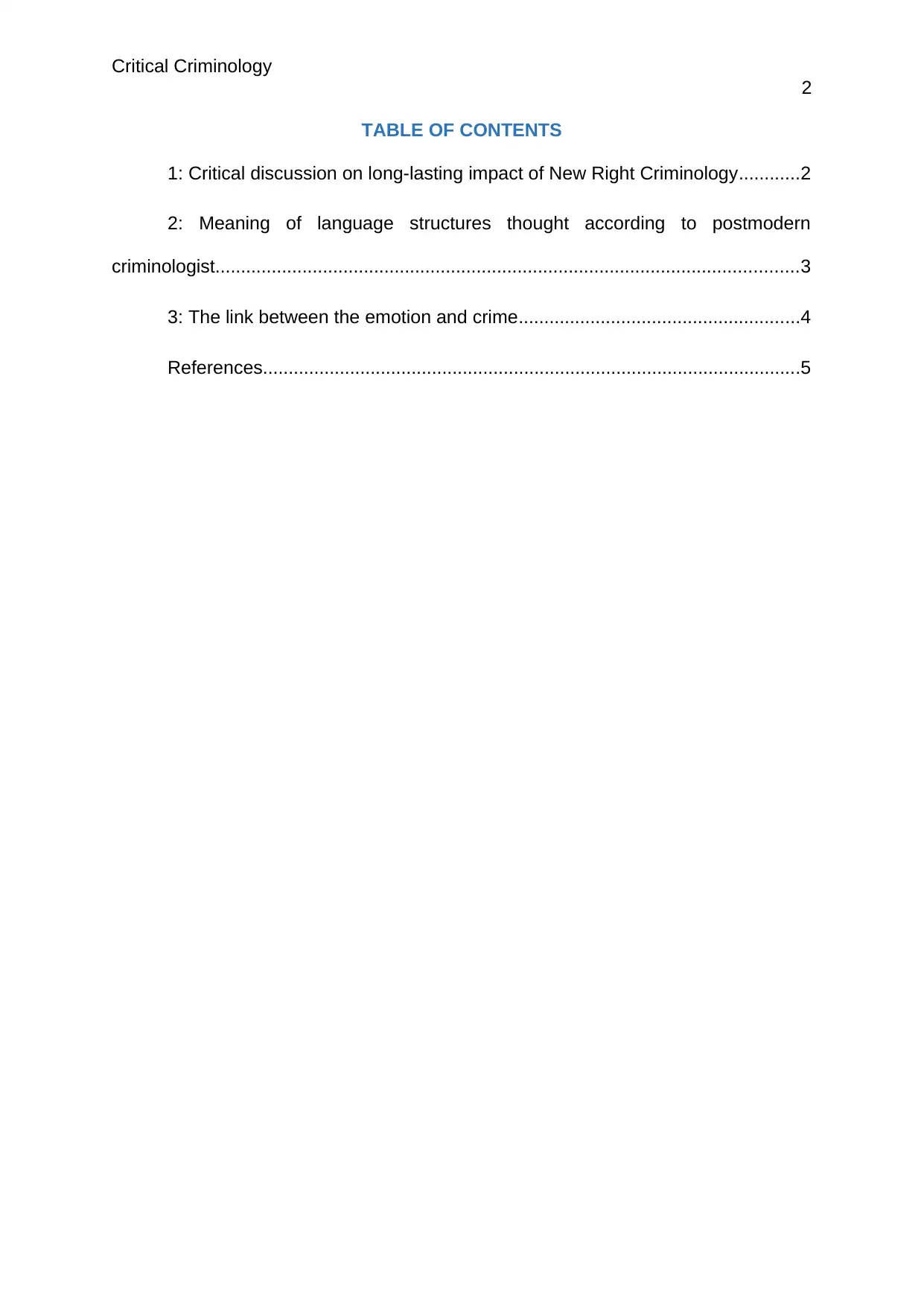
Critical Criminology
2
TABLE OF CONTENTS
1: Critical discussion on long-lasting impact of New Right Criminology............2
2: Meaning of language structures thought according to postmodern
criminologist..................................................................................................................3
3: The link between the emotion and crime.......................................................4
References.........................................................................................................5
2
TABLE OF CONTENTS
1: Critical discussion on long-lasting impact of New Right Criminology............2
2: Meaning of language structures thought according to postmodern
criminologist..................................................................................................................3
3: The link between the emotion and crime.......................................................4
References.........................................................................................................5
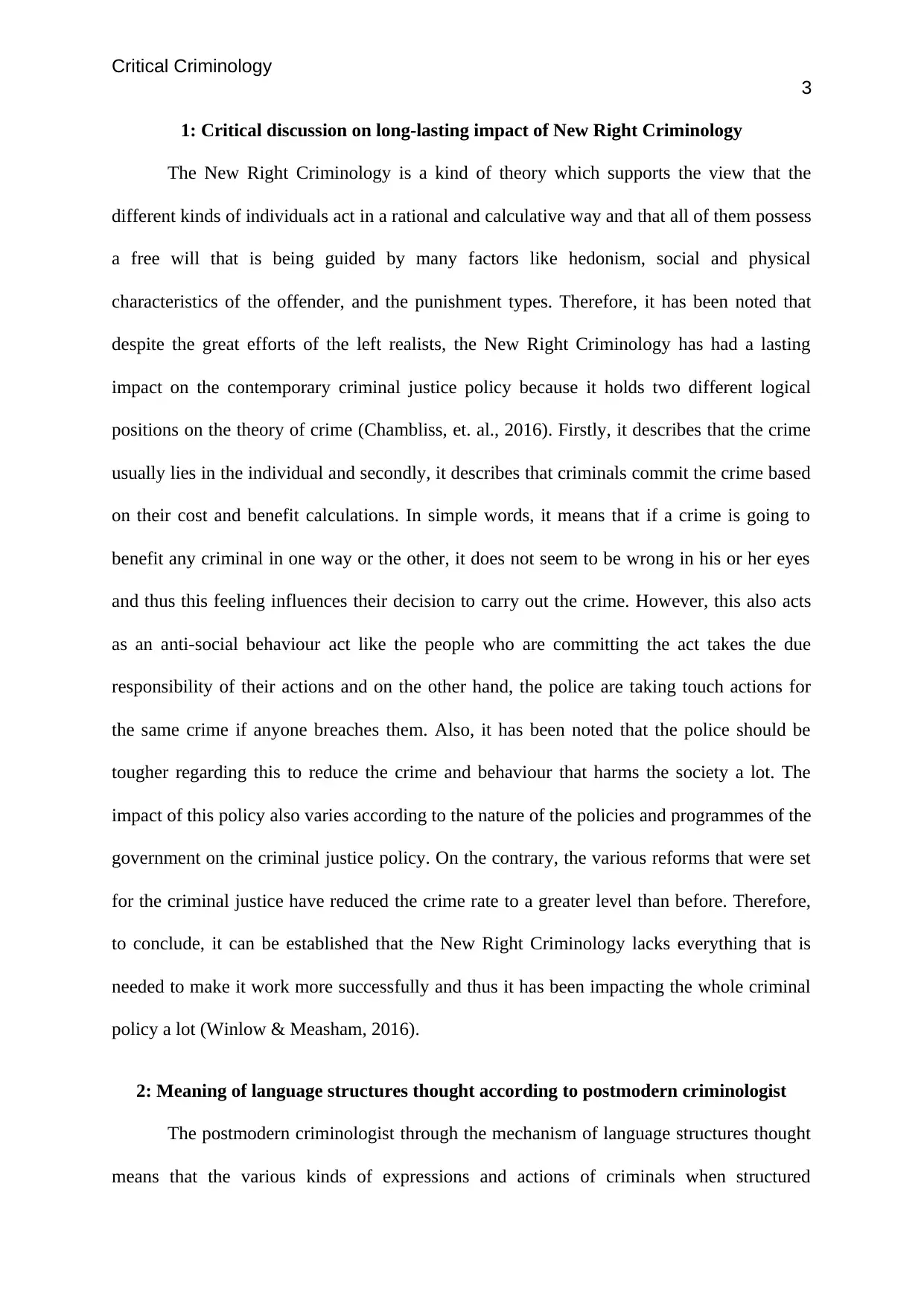
Critical Criminology
3
1: Critical discussion on long-lasting impact of New Right Criminology
The New Right Criminology is a kind of theory which supports the view that the
different kinds of individuals act in a rational and calculative way and that all of them possess
a free will that is being guided by many factors like hedonism, social and physical
characteristics of the offender, and the punishment types. Therefore, it has been noted that
despite the great efforts of the left realists, the New Right Criminology has had a lasting
impact on the contemporary criminal justice policy because it holds two different logical
positions on the theory of crime (Chambliss, et. al., 2016). Firstly, it describes that the crime
usually lies in the individual and secondly, it describes that criminals commit the crime based
on their cost and benefit calculations. In simple words, it means that if a crime is going to
benefit any criminal in one way or the other, it does not seem to be wrong in his or her eyes
and thus this feeling influences their decision to carry out the crime. However, this also acts
as an anti-social behaviour act like the people who are committing the act takes the due
responsibility of their actions and on the other hand, the police are taking touch actions for
the same crime if anyone breaches them. Also, it has been noted that the police should be
tougher regarding this to reduce the crime and behaviour that harms the society a lot. The
impact of this policy also varies according to the nature of the policies and programmes of the
government on the criminal justice policy. On the contrary, the various reforms that were set
for the criminal justice have reduced the crime rate to a greater level than before. Therefore,
to conclude, it can be established that the New Right Criminology lacks everything that is
needed to make it work more successfully and thus it has been impacting the whole criminal
policy a lot (Winlow & Measham, 2016).
2: Meaning of language structures thought according to postmodern criminologist
The postmodern criminologist through the mechanism of language structures thought
means that the various kinds of expressions and actions of criminals when structured
3
1: Critical discussion on long-lasting impact of New Right Criminology
The New Right Criminology is a kind of theory which supports the view that the
different kinds of individuals act in a rational and calculative way and that all of them possess
a free will that is being guided by many factors like hedonism, social and physical
characteristics of the offender, and the punishment types. Therefore, it has been noted that
despite the great efforts of the left realists, the New Right Criminology has had a lasting
impact on the contemporary criminal justice policy because it holds two different logical
positions on the theory of crime (Chambliss, et. al., 2016). Firstly, it describes that the crime
usually lies in the individual and secondly, it describes that criminals commit the crime based
on their cost and benefit calculations. In simple words, it means that if a crime is going to
benefit any criminal in one way or the other, it does not seem to be wrong in his or her eyes
and thus this feeling influences their decision to carry out the crime. However, this also acts
as an anti-social behaviour act like the people who are committing the act takes the due
responsibility of their actions and on the other hand, the police are taking touch actions for
the same crime if anyone breaches them. Also, it has been noted that the police should be
tougher regarding this to reduce the crime and behaviour that harms the society a lot. The
impact of this policy also varies according to the nature of the policies and programmes of the
government on the criminal justice policy. On the contrary, the various reforms that were set
for the criminal justice have reduced the crime rate to a greater level than before. Therefore,
to conclude, it can be established that the New Right Criminology lacks everything that is
needed to make it work more successfully and thus it has been impacting the whole criminal
policy a lot (Winlow & Measham, 2016).
2: Meaning of language structures thought according to postmodern criminologist
The postmodern criminologist through the mechanism of language structures thought
means that the various kinds of expressions and actions of criminals when structured
⊘ This is a preview!⊘
Do you want full access?
Subscribe today to unlock all pages.

Trusted by 1+ million students worldwide
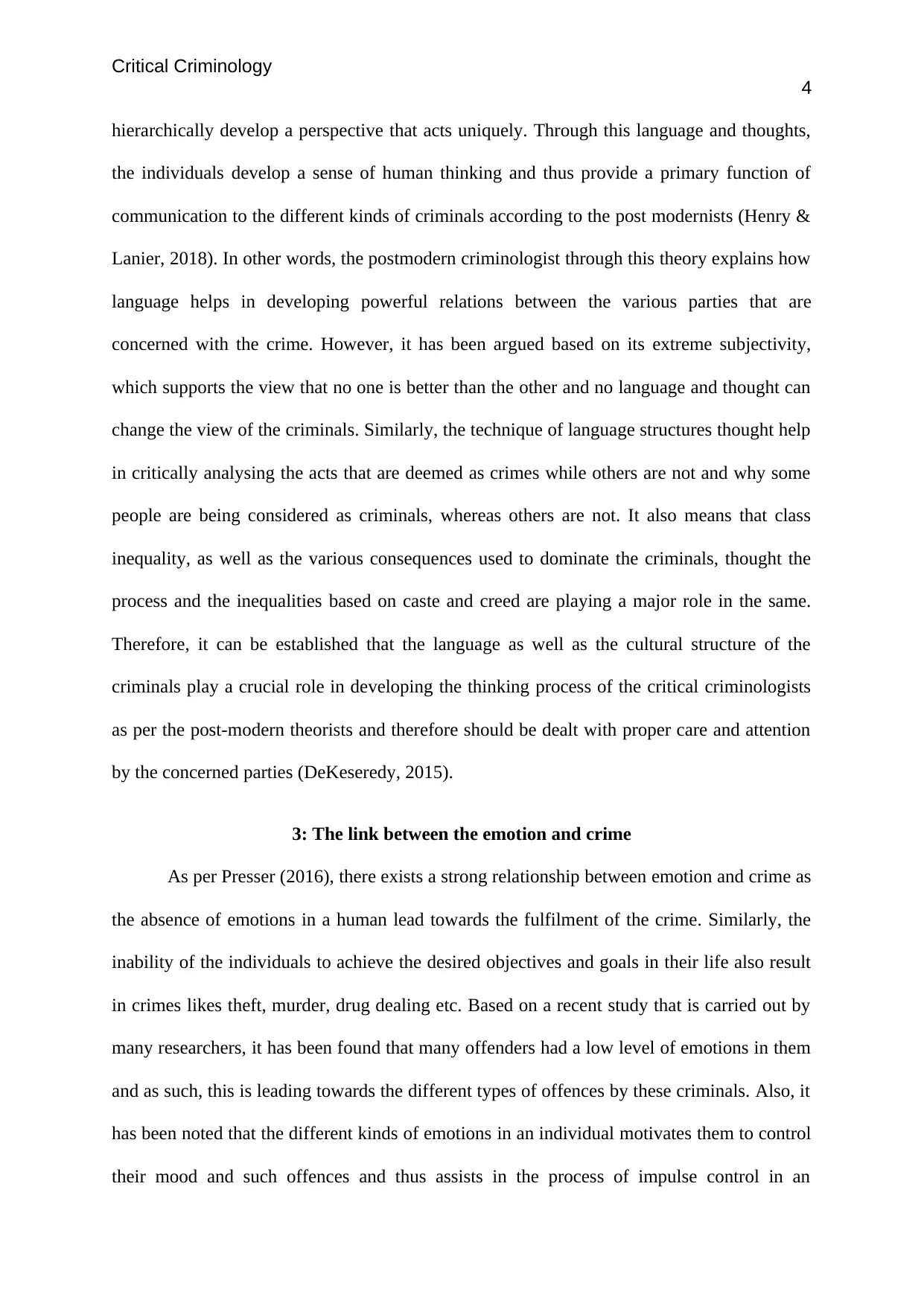
Critical Criminology
4
hierarchically develop a perspective that acts uniquely. Through this language and thoughts,
the individuals develop a sense of human thinking and thus provide a primary function of
communication to the different kinds of criminals according to the post modernists (Henry &
Lanier, 2018). In other words, the postmodern criminologist through this theory explains how
language helps in developing powerful relations between the various parties that are
concerned with the crime. However, it has been argued based on its extreme subjectivity,
which supports the view that no one is better than the other and no language and thought can
change the view of the criminals. Similarly, the technique of language structures thought help
in critically analysing the acts that are deemed as crimes while others are not and why some
people are being considered as criminals, whereas others are not. It also means that class
inequality, as well as the various consequences used to dominate the criminals, thought the
process and the inequalities based on caste and creed are playing a major role in the same.
Therefore, it can be established that the language as well as the cultural structure of the
criminals play a crucial role in developing the thinking process of the critical criminologists
as per the post-modern theorists and therefore should be dealt with proper care and attention
by the concerned parties (DeKeseredy, 2015).
3: The link between the emotion and crime
As per Presser (2016), there exists a strong relationship between emotion and crime as
the absence of emotions in a human lead towards the fulfilment of the crime. Similarly, the
inability of the individuals to achieve the desired objectives and goals in their life also result
in crimes likes theft, murder, drug dealing etc. Based on a recent study that is carried out by
many researchers, it has been found that many offenders had a low level of emotions in them
and as such, this is leading towards the different types of offences by these criminals. Also, it
has been noted that the different kinds of emotions in an individual motivates them to control
their mood and such offences and thus assists in the process of impulse control in an
4
hierarchically develop a perspective that acts uniquely. Through this language and thoughts,
the individuals develop a sense of human thinking and thus provide a primary function of
communication to the different kinds of criminals according to the post modernists (Henry &
Lanier, 2018). In other words, the postmodern criminologist through this theory explains how
language helps in developing powerful relations between the various parties that are
concerned with the crime. However, it has been argued based on its extreme subjectivity,
which supports the view that no one is better than the other and no language and thought can
change the view of the criminals. Similarly, the technique of language structures thought help
in critically analysing the acts that are deemed as crimes while others are not and why some
people are being considered as criminals, whereas others are not. It also means that class
inequality, as well as the various consequences used to dominate the criminals, thought the
process and the inequalities based on caste and creed are playing a major role in the same.
Therefore, it can be established that the language as well as the cultural structure of the
criminals play a crucial role in developing the thinking process of the critical criminologists
as per the post-modern theorists and therefore should be dealt with proper care and attention
by the concerned parties (DeKeseredy, 2015).
3: The link between the emotion and crime
As per Presser (2016), there exists a strong relationship between emotion and crime as
the absence of emotions in a human lead towards the fulfilment of the crime. Similarly, the
inability of the individuals to achieve the desired objectives and goals in their life also result
in crimes likes theft, murder, drug dealing etc. Based on a recent study that is carried out by
many researchers, it has been found that many offenders had a low level of emotions in them
and as such, this is leading towards the different types of offences by these criminals. Also, it
has been noted that the different kinds of emotions in an individual motivates them to control
their mood and such offences and thus assists in the process of impulse control in an
Paraphrase This Document
Need a fresh take? Get an instant paraphrase of this document with our AI Paraphraser
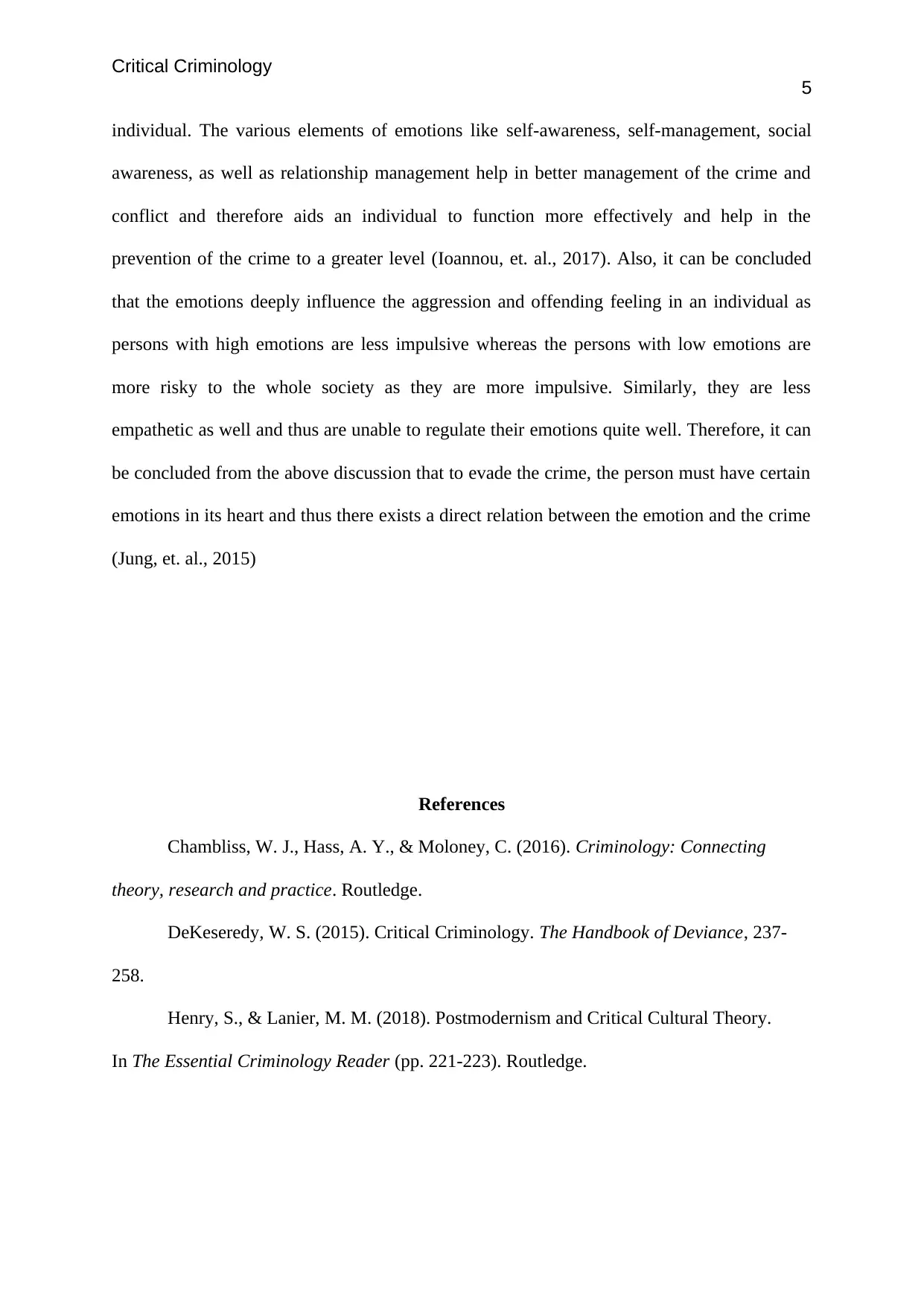
Critical Criminology
5
individual. The various elements of emotions like self-awareness, self-management, social
awareness, as well as relationship management help in better management of the crime and
conflict and therefore aids an individual to function more effectively and help in the
prevention of the crime to a greater level (Ioannou, et. al., 2017). Also, it can be concluded
that the emotions deeply influence the aggression and offending feeling in an individual as
persons with high emotions are less impulsive whereas the persons with low emotions are
more risky to the whole society as they are more impulsive. Similarly, they are less
empathetic as well and thus are unable to regulate their emotions quite well. Therefore, it can
be concluded from the above discussion that to evade the crime, the person must have certain
emotions in its heart and thus there exists a direct relation between the emotion and the crime
(Jung, et. al., 2015)
References
Chambliss, W. J., Hass, A. Y., & Moloney, C. (2016). Criminology: Connecting
theory, research and practice. Routledge.
DeKeseredy, W. S. (2015). Critical Criminology. The Handbook of Deviance, 237-
258.
Henry, S., & Lanier, M. M. (2018). Postmodernism and Critical Cultural Theory.
In The Essential Criminology Reader (pp. 221-223). Routledge.
5
individual. The various elements of emotions like self-awareness, self-management, social
awareness, as well as relationship management help in better management of the crime and
conflict and therefore aids an individual to function more effectively and help in the
prevention of the crime to a greater level (Ioannou, et. al., 2017). Also, it can be concluded
that the emotions deeply influence the aggression and offending feeling in an individual as
persons with high emotions are less impulsive whereas the persons with low emotions are
more risky to the whole society as they are more impulsive. Similarly, they are less
empathetic as well and thus are unable to regulate their emotions quite well. Therefore, it can
be concluded from the above discussion that to evade the crime, the person must have certain
emotions in its heart and thus there exists a direct relation between the emotion and the crime
(Jung, et. al., 2015)
References
Chambliss, W. J., Hass, A. Y., & Moloney, C. (2016). Criminology: Connecting
theory, research and practice. Routledge.
DeKeseredy, W. S. (2015). Critical Criminology. The Handbook of Deviance, 237-
258.
Henry, S., & Lanier, M. M. (2018). Postmodernism and Critical Cultural Theory.
In The Essential Criminology Reader (pp. 221-223). Routledge.
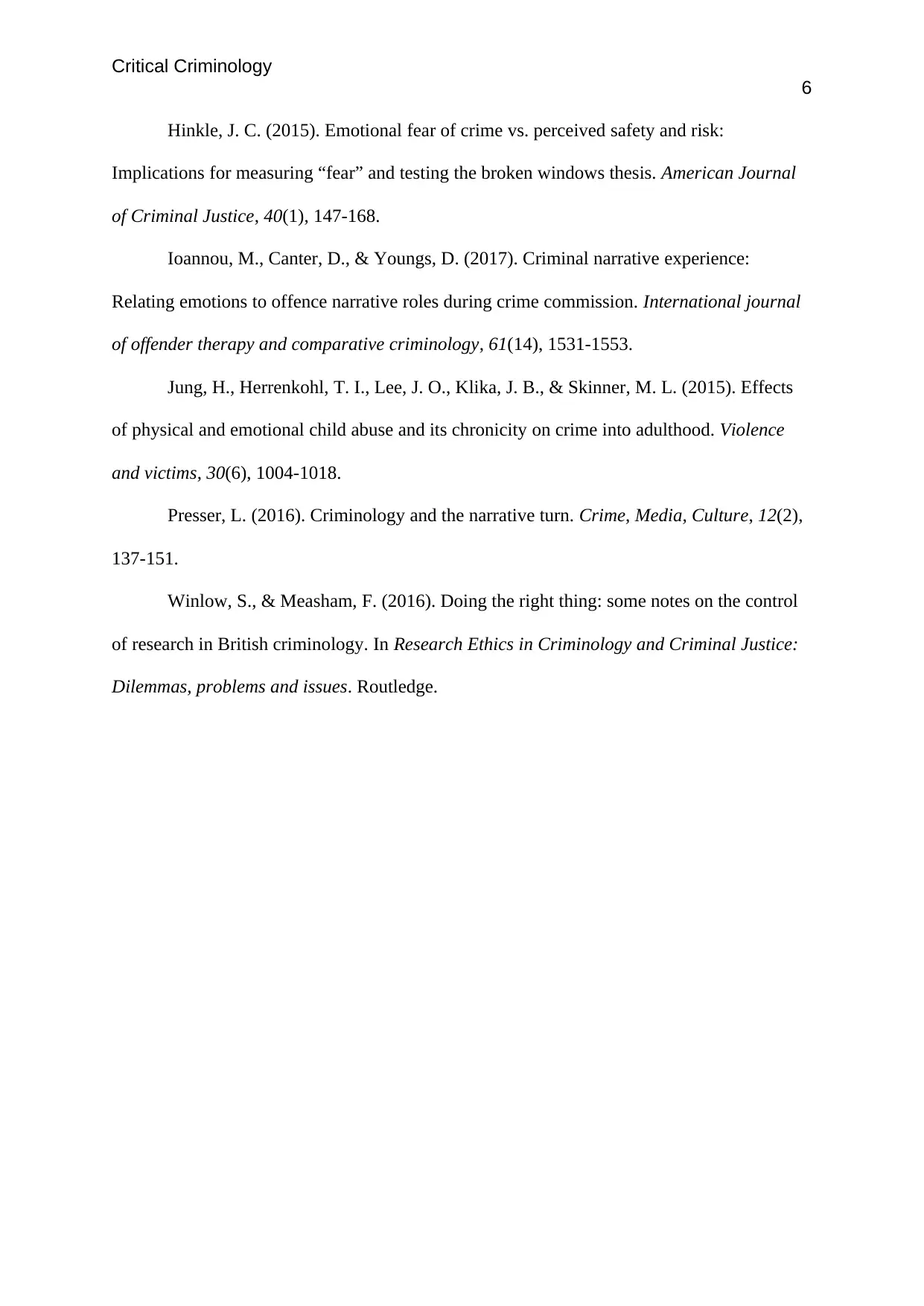
Critical Criminology
6
Hinkle, J. C. (2015). Emotional fear of crime vs. perceived safety and risk:
Implications for measuring “fear” and testing the broken windows thesis. American Journal
of Criminal Justice, 40(1), 147-168.
Ioannou, M., Canter, D., & Youngs, D. (2017). Criminal narrative experience:
Relating emotions to offence narrative roles during crime commission. International journal
of offender therapy and comparative criminology, 61(14), 1531-1553.
Jung, H., Herrenkohl, T. I., Lee, J. O., Klika, J. B., & Skinner, M. L. (2015). Effects
of physical and emotional child abuse and its chronicity on crime into adulthood. Violence
and victims, 30(6), 1004-1018.
Presser, L. (2016). Criminology and the narrative turn. Crime, Media, Culture, 12(2),
137-151.
Winlow, S., & Measham, F. (2016). Doing the right thing: some notes on the control
of research in British criminology. In Research Ethics in Criminology and Criminal Justice:
Dilemmas, problems and issues. Routledge.
6
Hinkle, J. C. (2015). Emotional fear of crime vs. perceived safety and risk:
Implications for measuring “fear” and testing the broken windows thesis. American Journal
of Criminal Justice, 40(1), 147-168.
Ioannou, M., Canter, D., & Youngs, D. (2017). Criminal narrative experience:
Relating emotions to offence narrative roles during crime commission. International journal
of offender therapy and comparative criminology, 61(14), 1531-1553.
Jung, H., Herrenkohl, T. I., Lee, J. O., Klika, J. B., & Skinner, M. L. (2015). Effects
of physical and emotional child abuse and its chronicity on crime into adulthood. Violence
and victims, 30(6), 1004-1018.
Presser, L. (2016). Criminology and the narrative turn. Crime, Media, Culture, 12(2),
137-151.
Winlow, S., & Measham, F. (2016). Doing the right thing: some notes on the control
of research in British criminology. In Research Ethics in Criminology and Criminal Justice:
Dilemmas, problems and issues. Routledge.
⊘ This is a preview!⊘
Do you want full access?
Subscribe today to unlock all pages.

Trusted by 1+ million students worldwide
1 out of 6
Related Documents
Your All-in-One AI-Powered Toolkit for Academic Success.
+13062052269
info@desklib.com
Available 24*7 on WhatsApp / Email
![[object Object]](/_next/static/media/star-bottom.7253800d.svg)
Unlock your academic potential
Copyright © 2020–2025 A2Z Services. All Rights Reserved. Developed and managed by ZUCOL.





